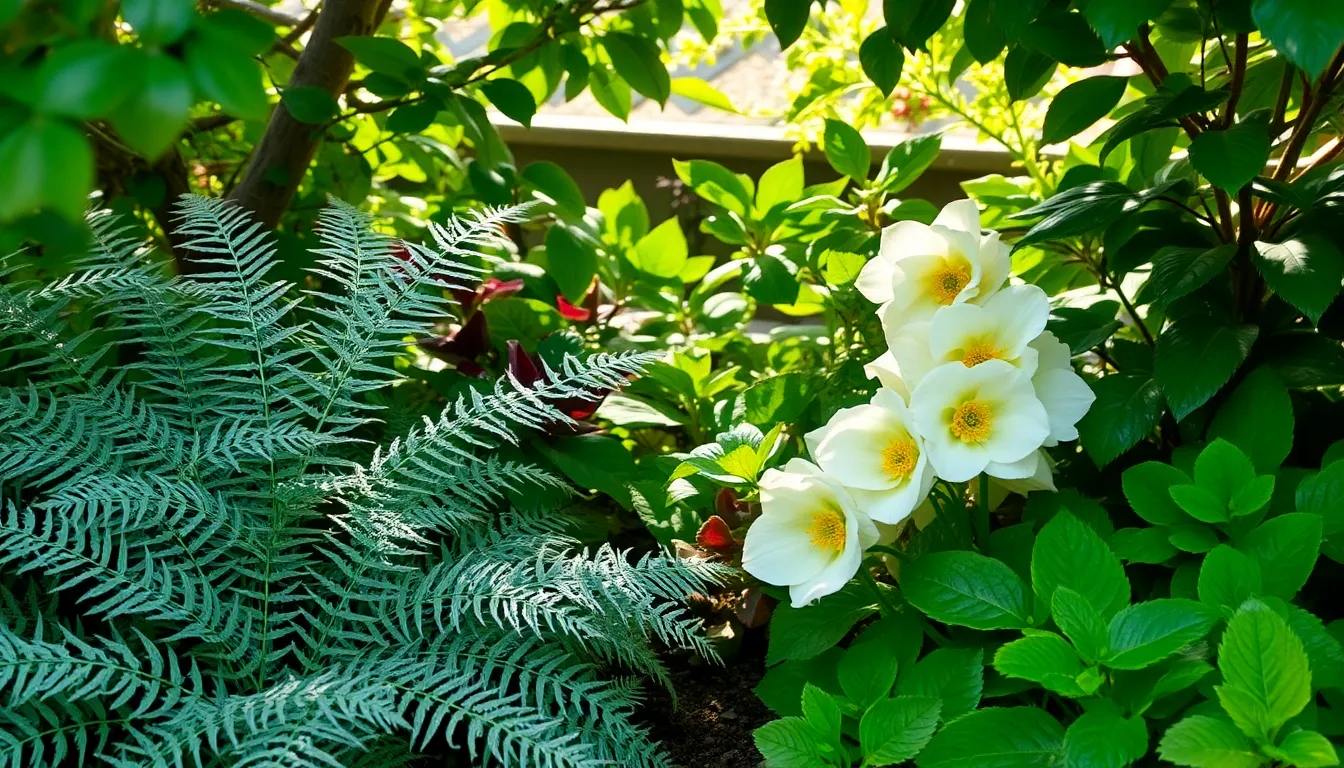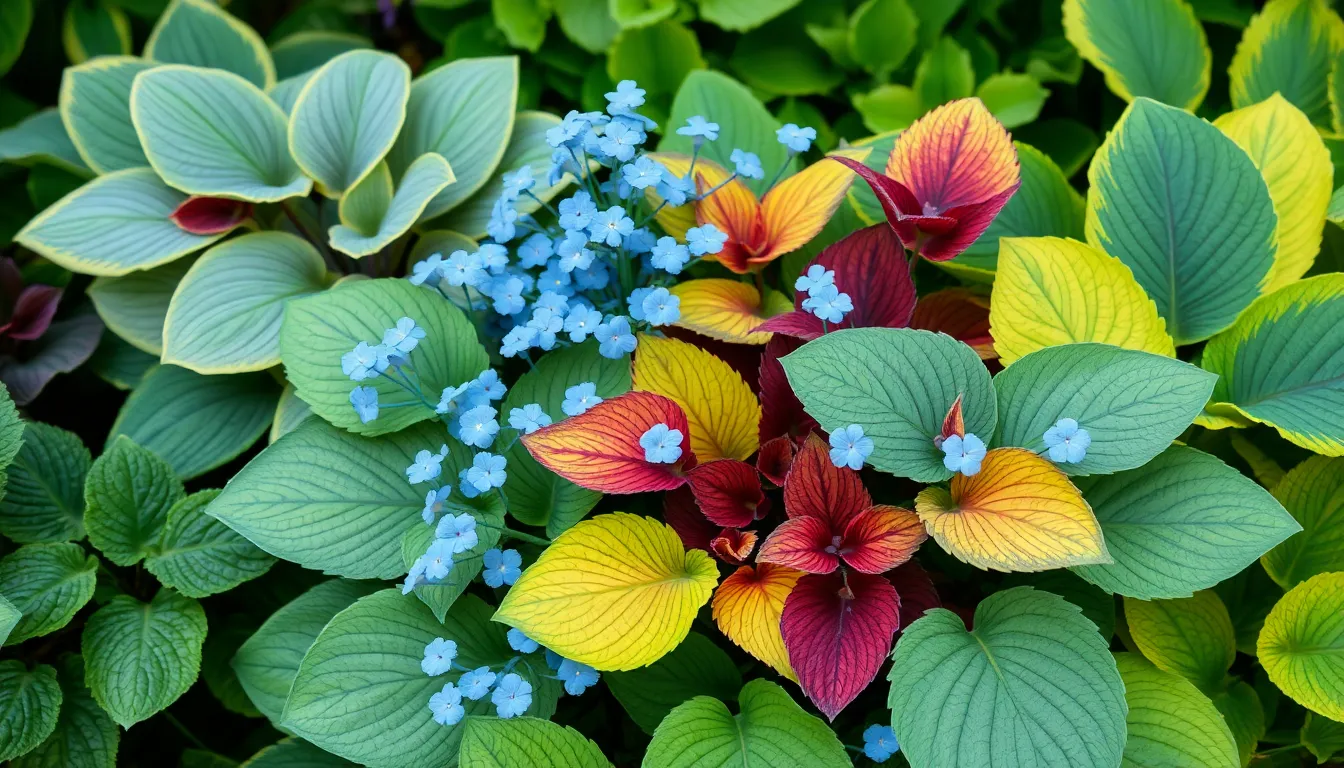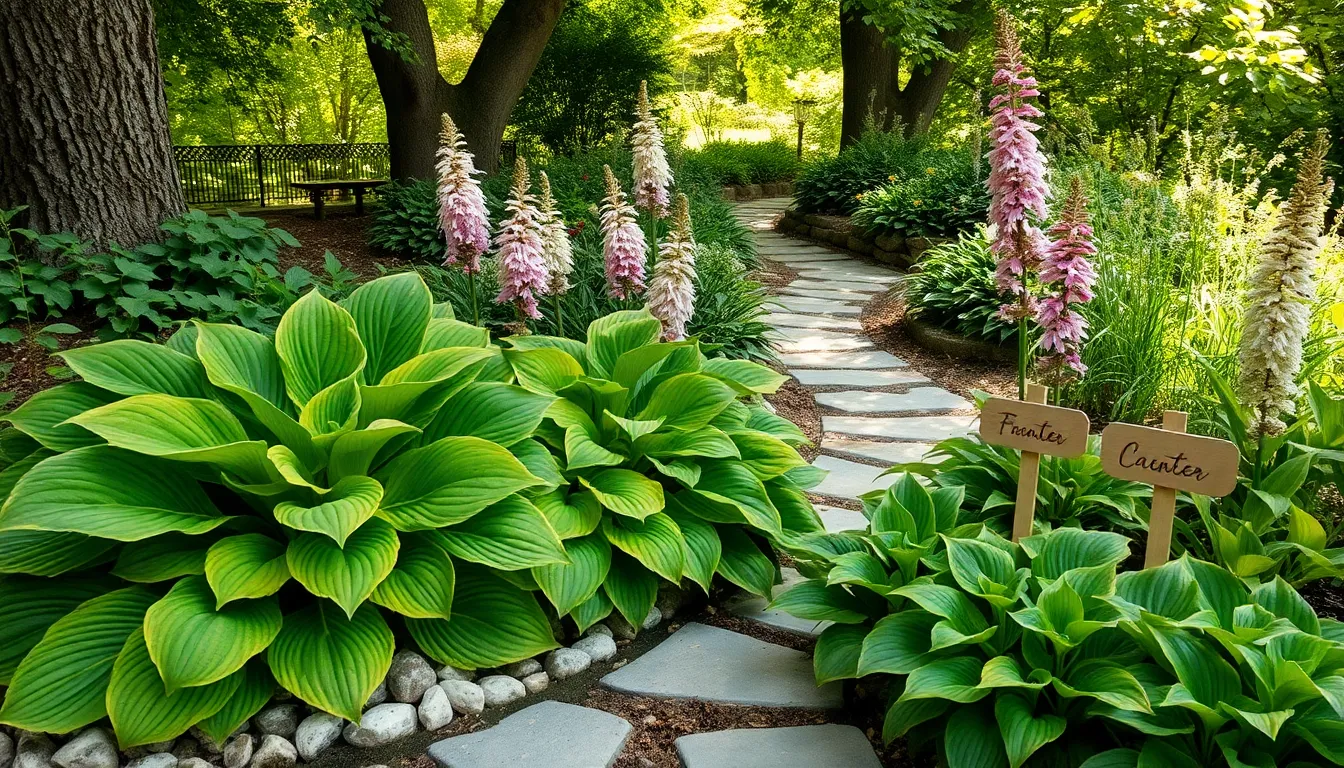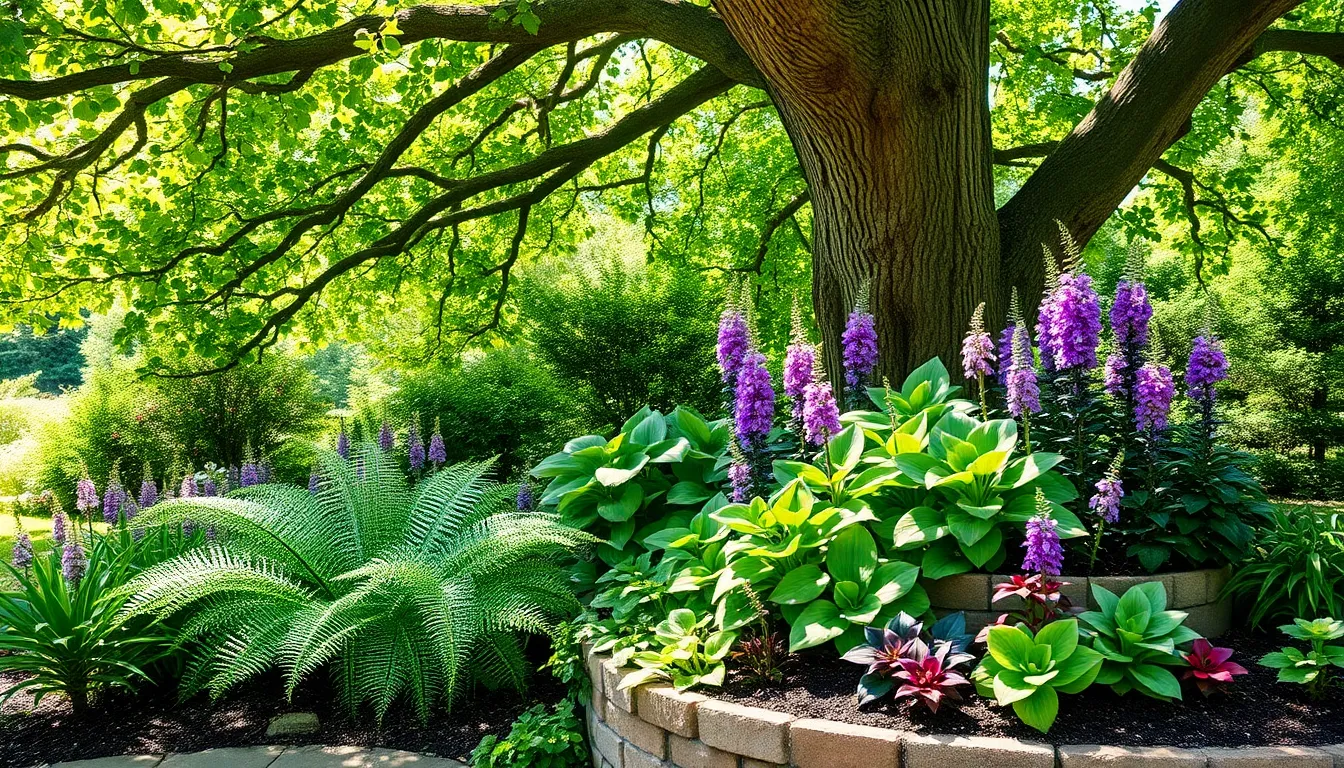Creating a garden that thrives in low-water, shaded conditions may seem like a challenge, but it’s a rewarding endeavor that both novice and seasoned gardeners can master. In an era where water conservation is crucial, choosing plants that flourish with minimal hydration not only respects our environment but also lightens the gardener’s workload.
In this article, we’ll explore ten exceptional plants that are perfectly suited for those tricky shaded areas of your garden, all while requiring minimal water. Whether you’re just starting out with your first garden or have been nurturing plants for years, you’ll discover a variety of hardy and beautiful options to enhance your outdoor space.
You’ll learn how to select the right plants that can thrive in the shade and still make a stunning impact with their foliage and blooms. Our guide will provide practical tips and insights to help you cultivate a lush, sustainable garden that conserves water without sacrificing beauty.
Understanding Shade Garden Dynamics
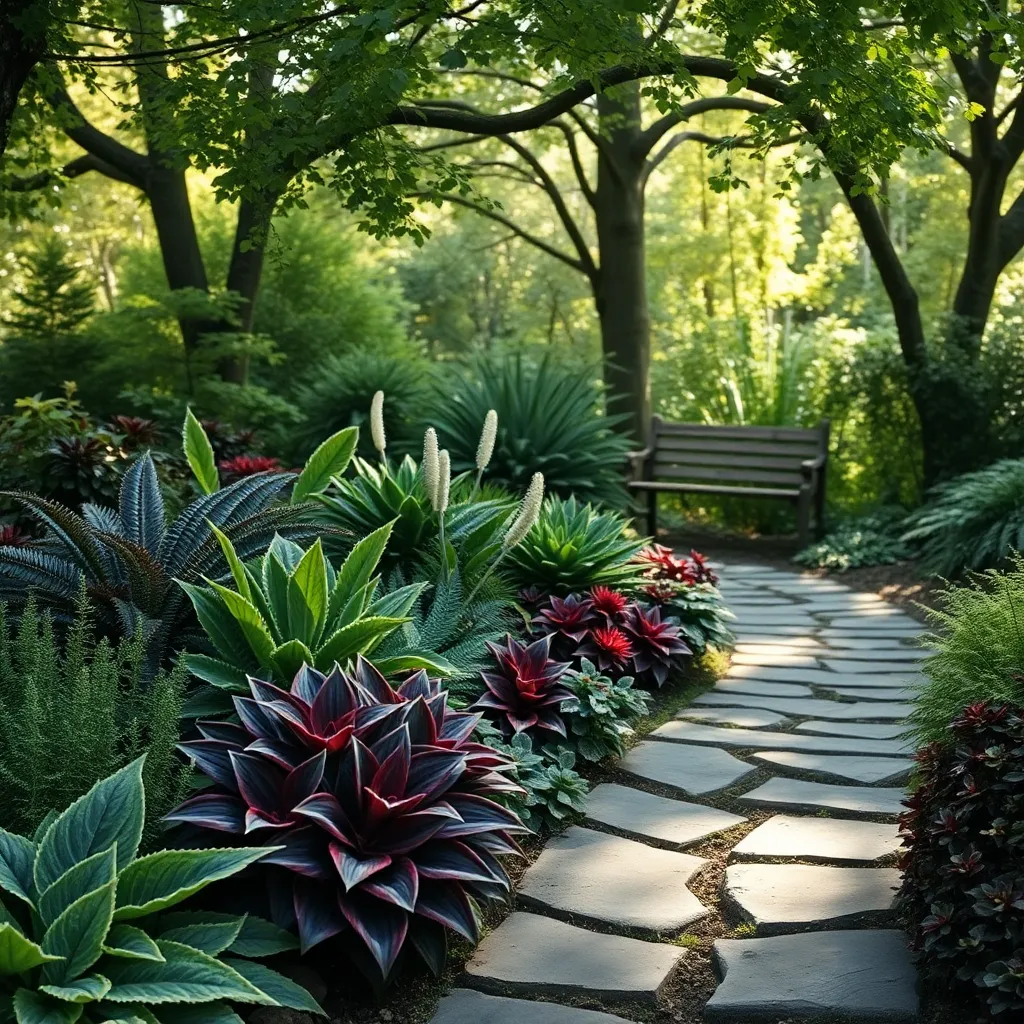
Understanding the dynamics of a shade garden is crucial for both plant health and aesthetic appeal. Shade gardens require specific attention to light levels, soil conditions, and moisture management to thrive.
Gardens in shaded areas often have cooler, more humid microclimates, which can affect plant growth. It’s essential to choose plants that are naturally adapted to lower light conditions and can tolerate these unique environments.
To optimize a shade garden, consider the type of shade—whether it’s deep, dappled, or partial—as this will guide your plant selection. For example, ferns and hostas thrive in deep shade, while astilbes can tolerate a bit more sunlight.
Soil preparation is another critical component in shade gardening. Improving drainage with organic matter, such as compost, can prevent root rot in areas where sunlight is limited and moisture persists.
Watering practices should be adjusted according to the shade level; deep shade requires less frequent watering compared to areas with partial sunlight. However, it’s important to ensure that the soil remains consistently moist, as shaded soil can dry out more slowly.
Advanced gardeners might consider creating layers within their shade garden to add depth and interest. This can be achieved by combining groundcovers like sweet woodruff with taller plants like bleeding hearts, offering a lush, multi-dimensional landscape.
Benefits of Low-Water Plants
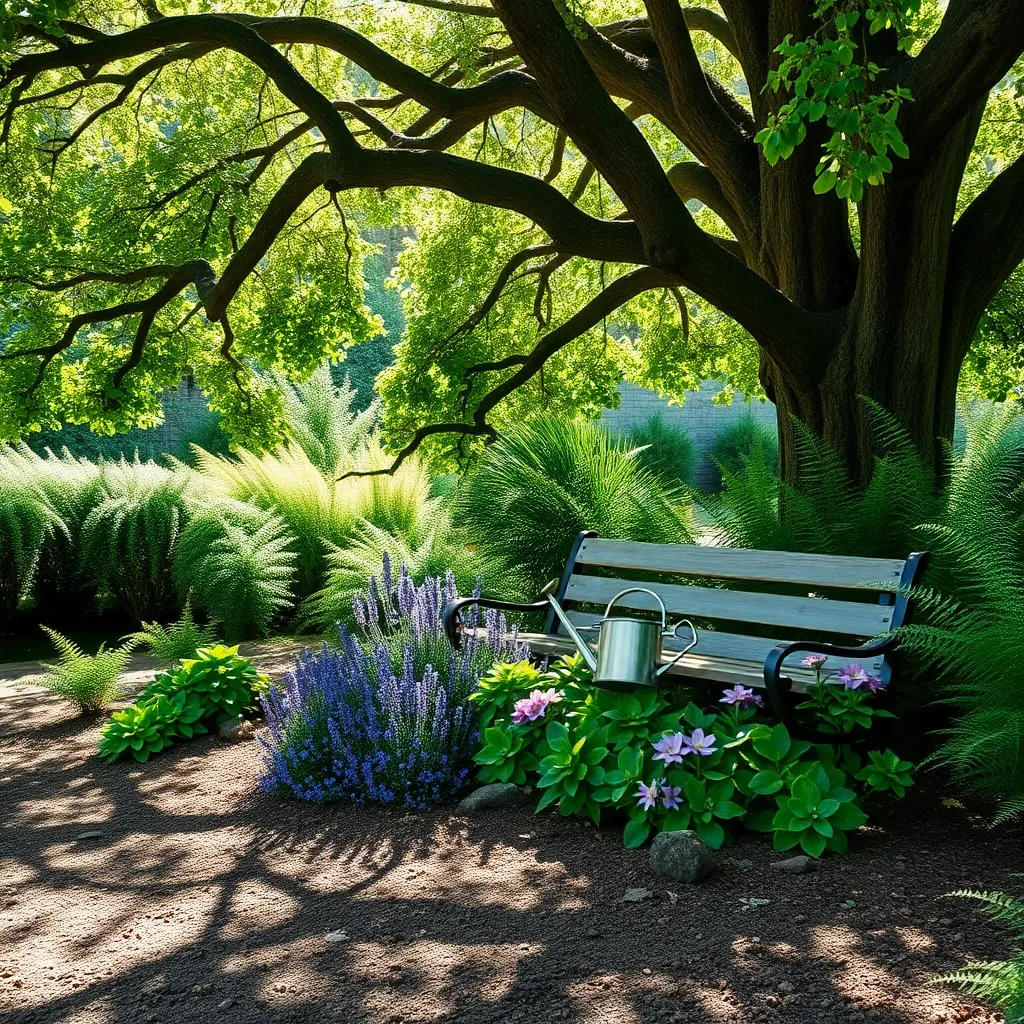
Low-water plants offer a sustainable solution for gardeners looking to reduce water usage without sacrificing beauty. They are particularly beneficial in areas prone to drought or where water restrictions are common, making them an environmentally friendly choice.
Additionally, these plants tend to be hardy and resilient, requiring less maintenance overall. This makes them an excellent choice for beginner gardeners who may not yet have developed a consistent watering routine.
For experienced gardeners, low-water plants present an opportunity to diversify their garden with unique textures and colors. Succulents, ornamental grasses, and many native species are great options that thrive with minimal water and add visual interest to shaded areas.
When incorporating low-water plants into your shade garden, consider using well-draining soil to prevent root rot. Amending the soil with sand or perlite can enhance drainage, which is especially important in shaded areas where moisture can linger longer.
Watering should be done deeply but infrequently, encouraging roots to grow deeper and become more drought-resistant. Aim to water early in the morning or late in the evening to minimize evaporation and maximize absorption.
For those looking to experiment, try grouping low-water plants with similar watering needs together. This not only simplifies irrigation but also creates a harmonious garden design that thrives under shared conditions.
Top Picks for Shady Spots
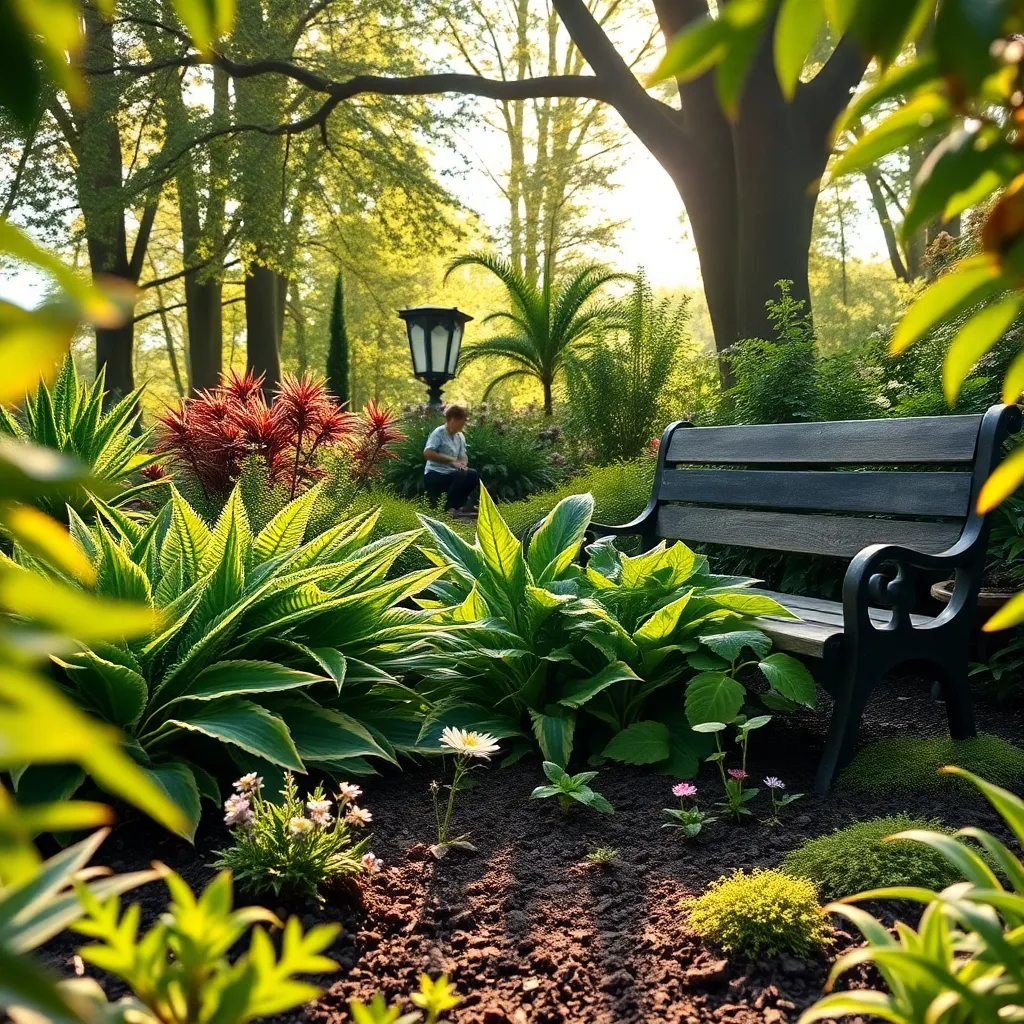
If you’re looking to make the most of your shaded garden areas with low-water plants, you’ve got some excellent options. One of the top choices is the Foamflower (Tiarella cordifolia), which thrives in partial to full shade. To keep your Foamflower healthy, plant it in well-drained soil enriched with organic matter. It requires minimal watering once established, making it a great choice for conserving water.
Another fantastic plant for shady spots is Heuchera (Coral Bells). These plants are not only drought-tolerant but also come in a variety of leaf colors that can add visual interest to your garden. For the best results, ensure they are planted in slightly acidic to neutral soil with good drainage. Water them deeply but infrequently to encourage deep root growth, which enhances their drought resistance.
Consider adding Japanese Forest Grass (Hakonechloa macra) to your shade garden for a touch of elegance. This grass prefers consistently moist soil, but once it’s well-established, it can handle drier conditions. To maintain its lush appearance, apply a layer of mulch to retain moisture and protect the roots. Additionally, dividing the plants every few years will help them stay vigorous and maintain their growth habit.
For a hint of color, try Astilbe, which produces beautiful plumes of flowers even in shady areas. Though they prefer consistently moist soil, they can adapt to less frequent watering once their root systems are developed. To enhance their performance, feed them with a slow-release fertilizer in early spring and trim back spent blooms to encourage new growth. With these tips, your shady garden will thrive with minimal water.
Care Tips for Dry Shade
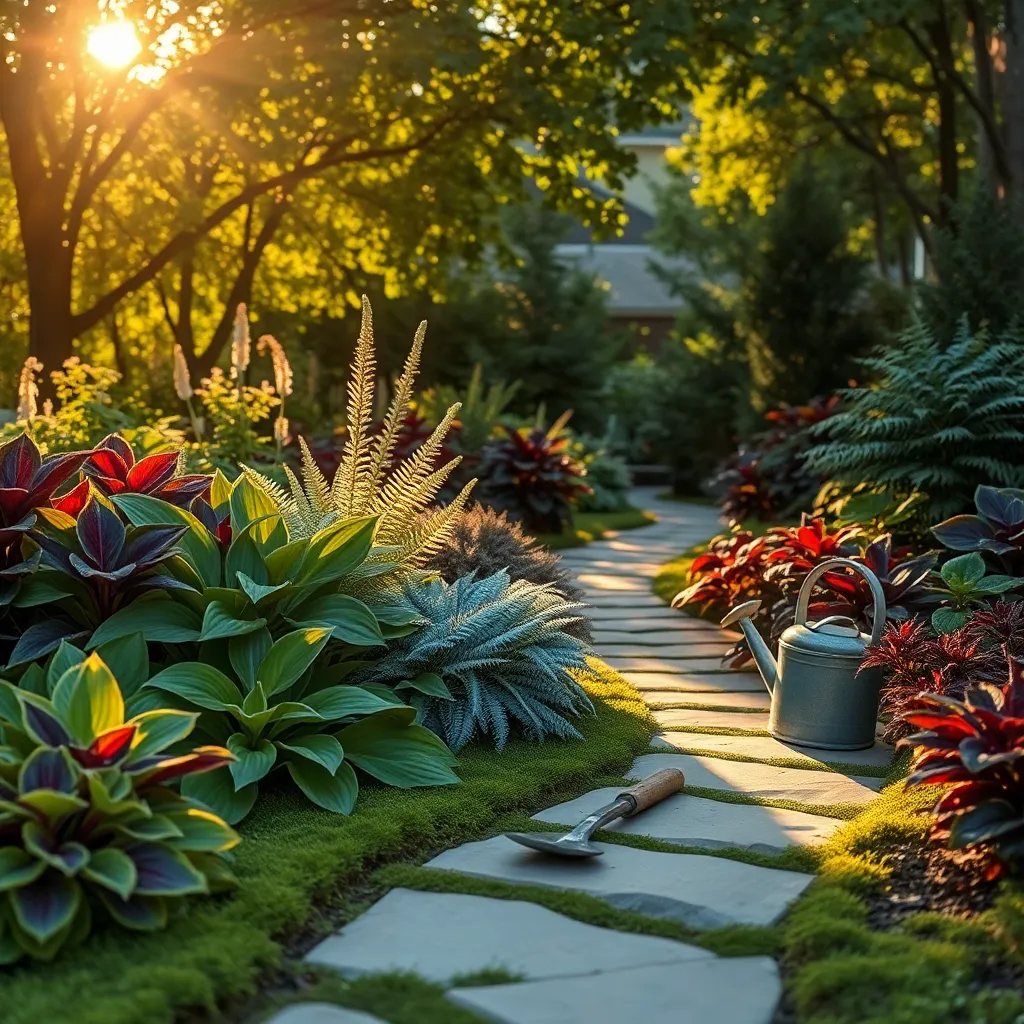
Dry shade gardens present a unique challenge, but with the right approach, they can thrive beautifully. Choose plants like hostas and ferns that are naturally adapted to low-water conditions and shade.
Improving soil quality is crucial for success in dry shade. Mix in plenty of organic matter, such as compost or well-rotted leaf mold, to enhance moisture retention and nutrient content.
Regular mulching helps maintain soil moisture and suppress weeds, which compete for limited resources. Apply a layer of organic mulch, about 2-3 inches thick, around your plants to keep the soil cool and conserve water.
Watering techniques are vital; use a soaker hose or drip irrigation system to deliver water directly to the roots. This method minimizes evaporation and ensures that plants receive the moisture they need without waste.
For those seeking advanced tips, consider planting in slightly raised beds to improve drainage and aeration. This can help prevent root rot and other moisture-related issues common in shaded areas.
Choosing Hardy Fern Varieties
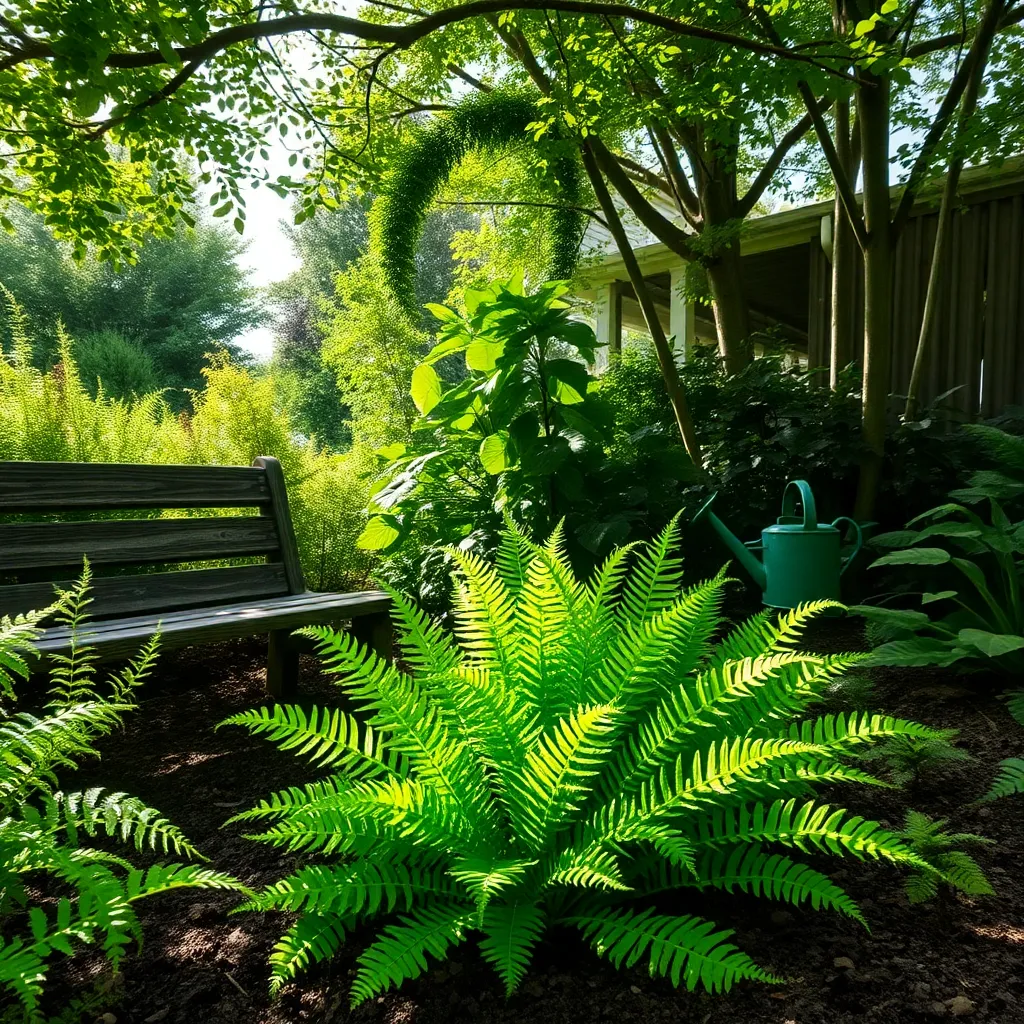
Ferns are an excellent choice for low-water shade gardens due to their adaptability and resilience. Hardy fern varieties like the Christmas Fern and the Japanese Painted Fern can thrive with minimal watering once established. These ferns are perfect for beginners because they require little maintenance beyond the occasional pruning of dead fronds. Ensure your ferns are planted in well-draining soil, as waterlogged conditions can lead to root rot.
When planting hardy ferns, it’s important to select a location that mimics their natural woodland habitat. Partial to full shade is ideal, and they benefit from a layer of organic mulch to retain moisture and keep roots cool. For those seeking a bit more visual interest, try planting the Autumn Fern, which offers striking coppery red fronds in the spring. Advanced gardeners might experiment with grouping different fern varieties to create a tapestry of textures and colors in their shade garden.
To help your ferns thrive, water them deeply during dry spells, especially in their first year. Once established, these plants are relatively drought-tolerant, making them a sustainable choice for water-conscious gardeners. Fertilizing isn’t necessary for hardy ferns, but they do appreciate a yearly top-dressing of compost to boost soil fertility. Regularly check for pests such as slugs and snails, which can damage the delicate fronds, and remove any affected leaves promptly to keep plants healthy.
Consider the soil acidity when choosing a fern variety, as some prefer slightly acidic conditions. Soil testing kits can help you assess and adjust the pH if needed, ensuring your ferns have the optimal growing environment. For a lush, evergreen look year-round, include the Western Sword Fern, which maintains its vibrant green fronds through winter. By selecting the right hardy fern varieties, you can enjoy a low-maintenance, water-efficient garden that thrives in the shade.
Groundcovers for Low-Water Areas
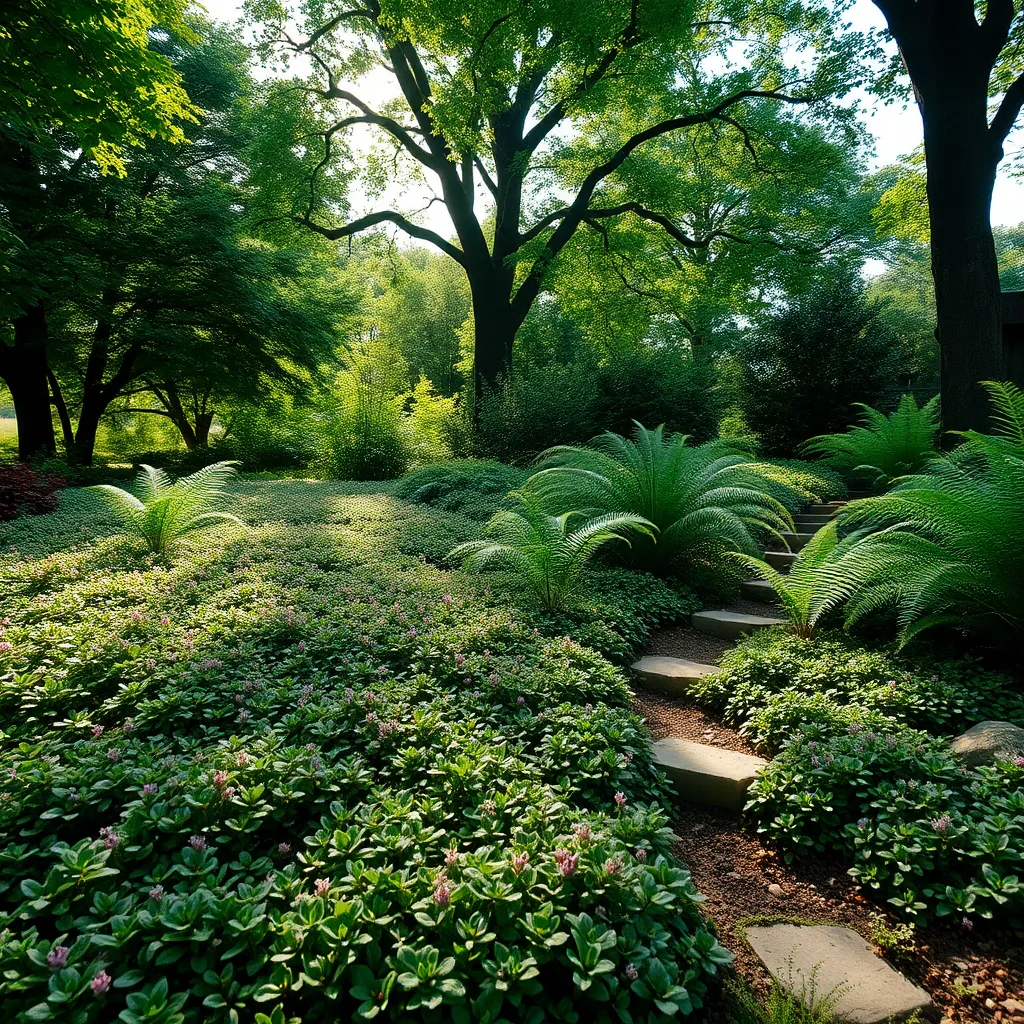
Groundcovers are an excellent choice for low-water areas, providing a lush carpet of greenery with minimal maintenance. One popular option is Dymondia margaretae, also known as Silver Carpet, which thrives in well-drained soil and low-light conditions.
To ensure your groundcovers establish well, plant them in early spring when the soil is moist. Regularly check the soil moisture content, but once established, these plants typically require watering only every two to three weeks.
For a more colorful option, consider using Lantana montevidensis, which offers vibrant blooms and is highly drought-tolerant. This plant prefers sandy or loamy soil and should be pruned back in late winter to encourage healthy growth.
Advanced gardeners might try combining different species of groundcovers to create an intricate tapestry of textures and colors. This not only enhances visual appeal but can also improve biodiversity and resilience in your garden plot.
Perennials for Dim Spaces
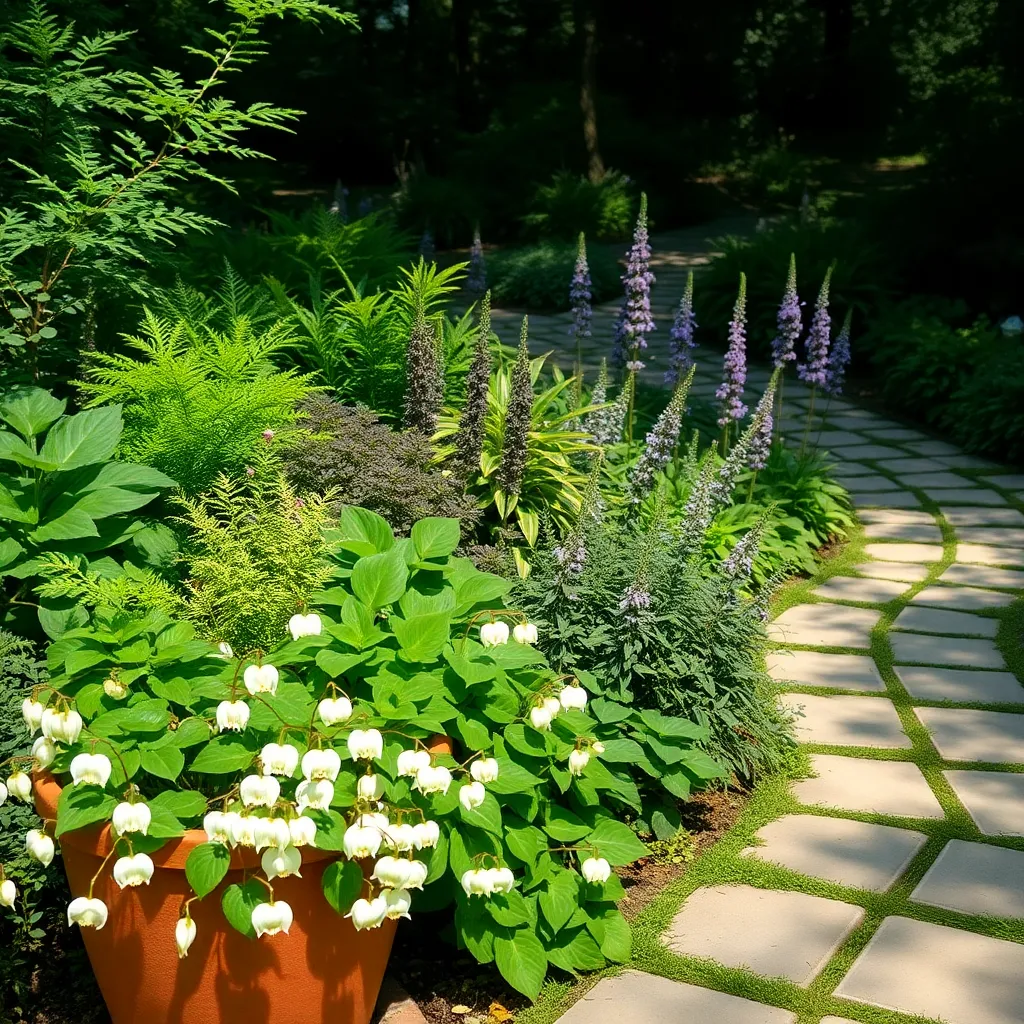
Perennial plants that thrive in dim spaces can transform a shady corner into a lush retreat. Hostas, with their broad, textured leaves, are an excellent choice for low-light areas and require minimal water once established.
To ensure your hostas flourish, plant them in well-draining soil enriched with organic matter. Mulch around the base to retain moisture and suppress weeds, which can compete for nutrients.
Another excellent option for dim spaces is the Astilbe, known for its feathery plumes and ability to thrive in moist, shaded areas. Although it prefers consistent moisture, Astilbe can tolerate brief dry spells once fully grown.
Consider the Heuchera, or coral bells, for their vibrant foliage that adds color throughout the year. These plants prefer slightly acidic to neutral soil and appreciate a layer of mulch to keep their roots cool and moist.
Incorporating Drought-Tolerant Shrubs
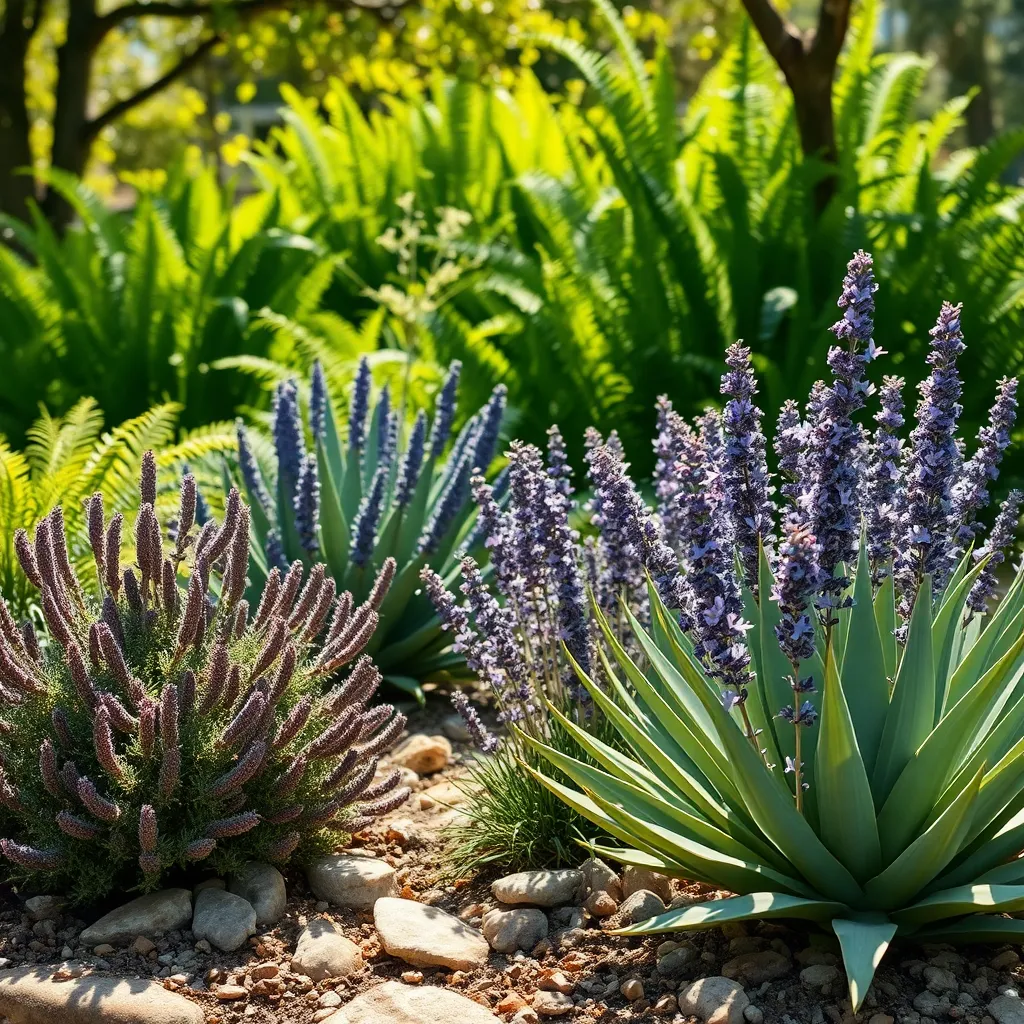
Incorporating drought-tolerant shrubs into your shade garden can be both aesthetically pleasing and water-efficient. These plants require minimal watering once established, making them a great choice for gardeners looking to conserve resources.
One excellent option is the Mahonia, known for its striking, holly-like leaves and vibrant yellow flowers. It thrives in partial shade and prefers well-draining soil, making it a resilient addition to shady spots.
Another suitable shrub is the Oregon Grape, which can adapt to a variety of soil types but performs best in slightly acidic conditions. Provide a layer of mulch around its base to retain moisture and improve soil quality.
For those with more space, the Serviceberry offers both beauty and utility with its delicate spring blossoms and edible berries. It prefers a location with dappled shade and benefits from occasional pruning to maintain shape and encourage healthy growth.
Companion Planting Strategies
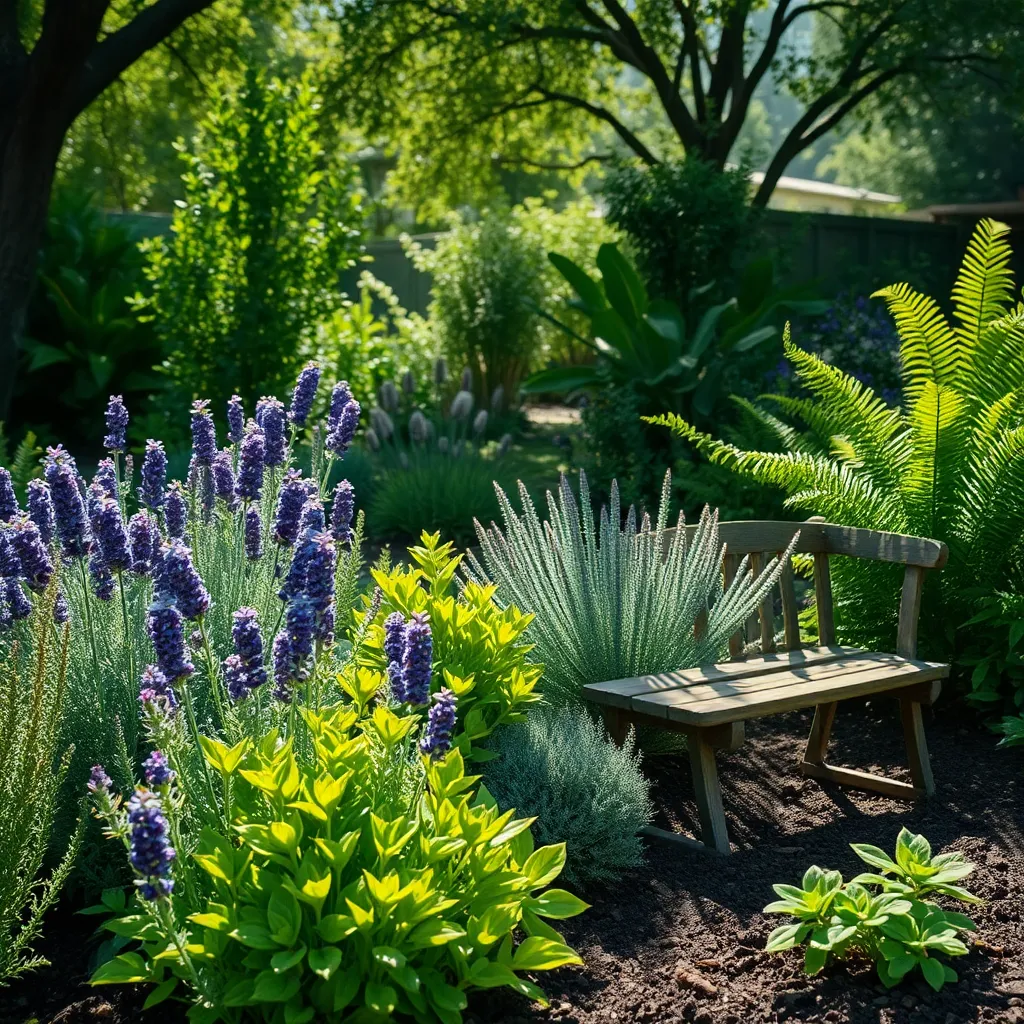
Companion planting in a low-water shade garden can enhance plant health and growth. By strategically pairing plants, you can create a balanced ecosystem that requires less maintenance.
For instance, pairing drought-tolerant plants like Heuchera with ferns can help maximize moisture retention in the soil. Heuchera’s ability to thrive in shade and its low water needs complement the fern’s preference for damp, shaded conditions, fostering a mutually beneficial environment.
Additionally, using ground covers like creeping thyme can help suppress weeds and reduce water evaporation around your shade-loving plants. Creeping thyme is an excellent choice as it withstands dry conditions once established and can add a lovely aroma when walked upon.
Consider planting shade-tolerant herbs like chives alongside your low-water garden plants. Chives not only add a culinary benefit but also deter pests, providing natural pest control without the need for chemical interventions.
Enhancing Shade with Mulching
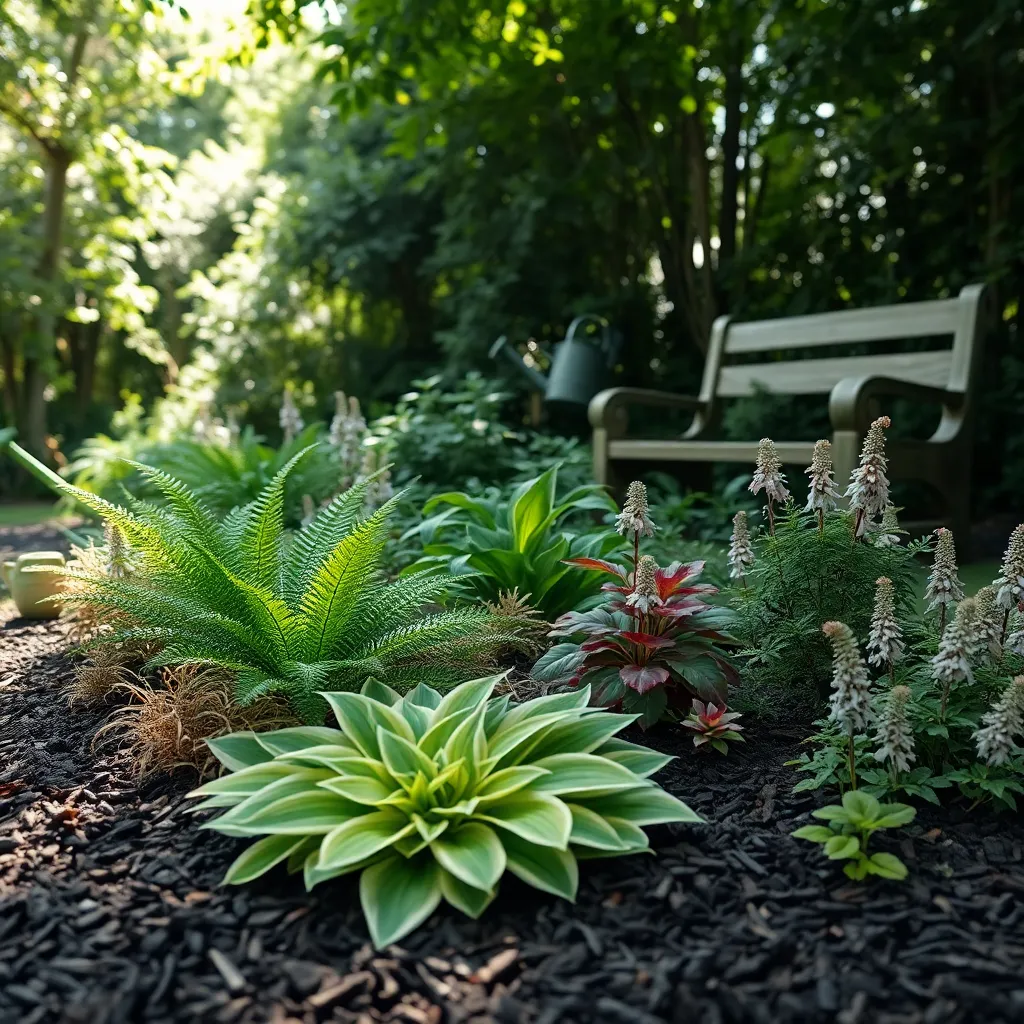
Enhancing shade in your garden with mulching can significantly improve moisture retention, which is crucial for low-water gardening. By using organic mulch like shredded bark or leaf mold, you can create a cooler, more consistent environment for your shade-loving plants.
Applying a layer of mulch about 2 to 4 inches thick helps suppress weeds, reducing competition for water and nutrients. It’s essential to keep the mulch a few inches away from plant stems to prevent rot and allow for adequate airflow.
While mulching is beneficial for conserving moisture, it also enriches the soil as it breaks down, providing a slow release of nutrients. To maximize these benefits, consider using a mulch that complements your soil type; for instance, pine needles are excellent for acidic soils.
For gardeners looking for a more advanced approach, consider using a living mulch, such as ground cover plants that thrive in shade. Options like sweet woodruff or ajuga can add both aesthetic value and functional moisture retention, enhancing the overall health of your shade garden.
Conclusion: Growing Success with These Plants
As we wrap up our exploration into the “10 Low-Water Shade Garden Plants” for nurturing relationships, let’s revisit the key insights that can transform your relational landscape. We discussed the importance of adaptability, much like the versatile Hosta, and the significance of patience, akin to the slow-growing Fern. We highlighted resilience, inspired by the hardy Heuchera, and the value of communication, as symbolized by the vibrant Bleeding Heart. Trust was illustrated through the dependable Solomon’s Seal, while empathy was mirrored by the nurturing Astilbe. We also touched on consistency, represented by the steadfast Epimedium, and the grace of forgiveness, much like the forgiving Tiarella. Lastly, embracing change was likened to the transformative Japanese Forest Grass, and the power of shared growth was symbolized by the community-loving Ajuga.
Now, take a moment to reflect on which of these qualities you can nurture in your own relationships today. As a practical next step, choose one plant as a metaphor to focus on cultivating its corresponding quality this week.
Remember, successful relationships are a garden that flourishes with care and attention. Bookmark this article to revisit these insights whenever you need a gentle reminder of how to cultivate a thriving relationship. Embrace the journey of growth and transformation, and witness your relationships bloom with renewed vitality and depth.

